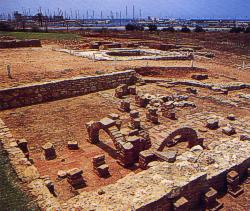|
Loulé |
|
| Portugal > Tourism > Algarve > Loulé > History | |
|
|
|
| As is the case across most of the Algarve, the human presence in the area can be dated back to the Paleolithic period from artifacts found on the surface. There is a more varied and more significant archaeological record of the Neolithic period (4, 000 to 1,500 BC) however. From the Chalcolithic to the time of the Roman occupation, mining operations, such as those in the Alte area, were the chief motivation for the establishment of settlements in the interior. Under the Romans there were several fishing and fish salting centers dotted along the coast, the best documented of which is the "villa' at Cerro da Vila in Vilamoura. It is also clear from archaeological finds that the Romans settled the spot on which Loulé castle now stands as well. Although the Visigoths left no trace of their passing, the same is not true of the Moors (8th to 13th centuries), for whom Loulé was an urban center of some importance. The Christian reconquest, in 1249, and the policy pursued throughout the Algarve of allowing the Moors to remain in quarters outside the city walls - known as Mourarias - made it possible for Loulé to continue to develop. With the initiation of a fair, in 1291, Loulé became one of the major focal points for trade in the Algarve in medieval times. |
| There are several sites dating back to the Aiegalithic period that merit a visit: the dolmen at Cerro das Pedras and the fallen menhir at Alagoas, which is made of limestone that must have been brought a considerable distance, both of which are in the vicinity of Salir; and the dolmens at Beringel and Pedra do Alagar (Ameixial). The mosaics visible in some of its apartments and the structure of its baths make the rural "villa" at Cerro da Vila (3rd century) the region's most eloquent testimony to the period of Roman occupation. The site was inhabited from the 1st to the 9th centuries, into the period of :Moorish rule. Other Roman structures include the bridge at Tor, over the pretty Algibre river, which has five arches and sturdy piers, the bridge at Barão, over the Quarteira river, which has only four arches, and near Loulé, the Alamos |
|
 |
| bridge, which is a more modest affair, with just two arches. Near the coast, the remains of `'cetairas' - tanks used to salt fish - at the Loulé Velho archaeological site provide further confirmation of the intense fishing and fish-preserving industry that existed for centuries in the Algarve under the Romans. |
|
|
|
| Portugal > Tourism > Algarve > Loulé > History | |
|
History |
|